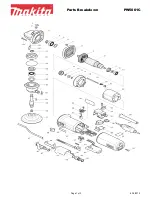
9
cessories that rotate faster than the permissible
level can rupture.
– Self-adhesive abrasives must be attached con-
centrically on the sanding pad.
Risk at work station
– Slipping and tripping hazard! Pay attention to
slippery surfaces and tripping hazards as a result
of air pressure hoses.
– Not intended for use in explosive atmospheres
and not insulated against contact with electrical
power sources.
– Proceed with caution in unfamiliar surroundings
that may contain electrical or other supply cables
that harbour hidden dangers. Ensure that there
are no electrical cables, gas pipelines or similar
that, if damaged, could pose a hazard when the
machine is used.
Hazard as a result of dust and vapours
– If hazardous dust is produced during sanding, the
machine should be connected to an appropriate
extractor and the safety regulations that apply to
the working material should be observed.
– A risk assessment in relation to this hazard must
be carried out and corresponding control mech-
anisms implemented. Arising dust must be fac-
tored in.
– Connect the dust extractor. Make sure that avail-
able dust extraction equipment is connected and
used correctly. Observe the regional safety regu-
lations for hazardous dusts and vapours. Operate
and service the compressed air tool as described
in the recommendations included in these in-
structions and use accessories and attachments
from Festool to minimise the release of dust and
vapours into the atmosphere. In dusty environ-
ments, make sure that the dissipation of exhaust
air does not disturb the dust.
– If necessary arising dust or vapours must be con-
trolled at the place of their release.
– All components must be fitted correctly and meet
all requirements to ensure that the compressed
air tool operates correctly.
– Select, maintain and replace accessories and
consumables according to these operating in-
structions.
– Wear a dust mask. Observe instructions from the
employer or occupational and health regulations.
Noise hazard
– Higher noise level can lead to permanent hearing
damage, loss of hearing or other problems if in-
adequate hearing protection is not worn or avail-
able.
– A risk assessment in relation to this hazard must
be carried out and corresponding control mech-
anisms implemented, e.g. the use of insulating
materials.
– Wear ear protection. Observe instructions from
the employer or occupational and health regula-
tions.
– Operate and maintain compressed air tool ac-
cording to these operating instructions.
– Select, maintain and replace accessories and
consumables according to these operating in-
structions.
– Assure function of the silencer at the com-
pressed air tool.
Vibration hazard
– Vibrations can cause damage to nerves and prob-
lems with blood circulation in hands and arms.
– When working in cold environments wear warm
clothing and keep hands warm and dry.
– In the event of numbness, tingling or pains in fin-
gers or hands or white colouration of the fingers
or hands, cease work, inform employer and con-
sult a doctor.
– Operate and maintain compressed air tool ac-
cording to these operating instructions.
– Do not hold the compressed air tool too tight, but
with a secure grip while observing the necessary
hand reaction forces. The vibration risk is greater
with increasing gripping strength.
Additional safety information for pneumatic ma-
chines
– Compressed air can cause serious injuries.
– Disconnect the compressed air hose from
the compressed air supply. In the event of
non-use of the compressed air tool, before
maintenance and when changing inser-
tion tools.
– Never direct the air flow towards yourself
or other persons.
– Hoses flapping around can cause serious inju-
ries. Check whether hoses and their fixing devic-
es have not suffered damage or become loose.
– The operating pressure should not exceed 6.2 bar
(90 psi).
– The machine must not be operated at a higher
speed than 6500 min
-1
– Never carry the compressed air tool by the com-
pressed air hose.










































